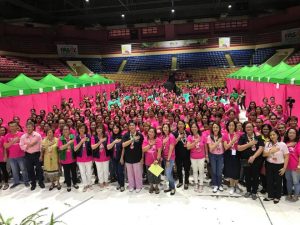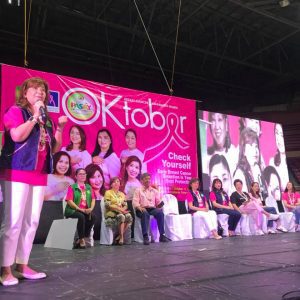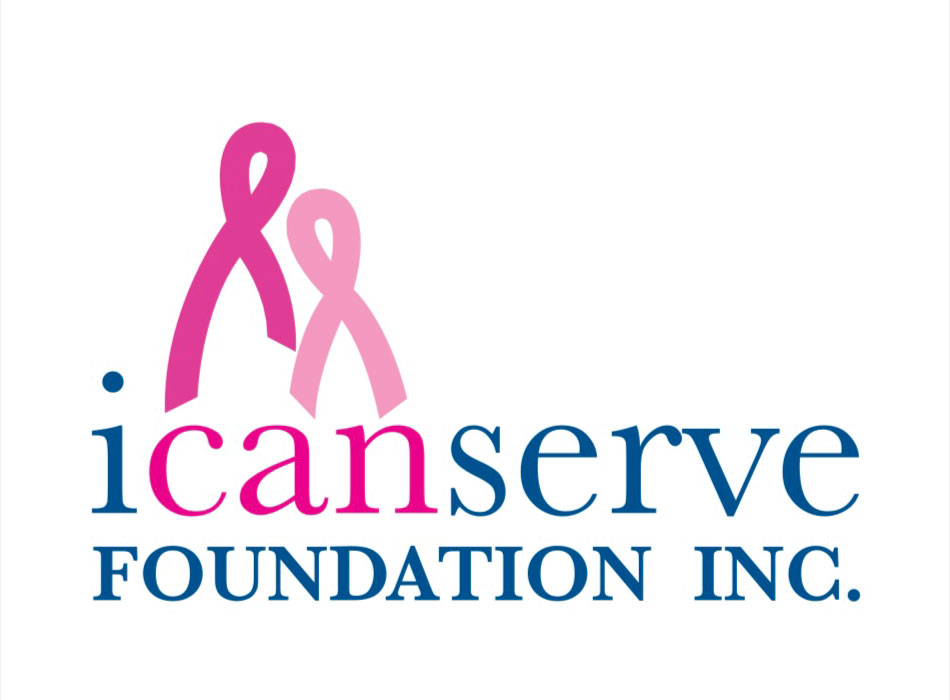
ICanServe volunteers, the Metro Manila Mayors’ Spouses’ Foundation, and the women of Pasay pledge to fight breast caner at the Cuneta Astrodome (October 11, 2018)

Metro Manila Mayors’ Spouses Foundation president and Paranaque first lady Janet Olivarez addresses the crowd
The first things we saw as we entered the Cuneta Astrodome in Pasay last October 11 was breast cancer survivor Mimi Martin leading a bunch of women in a Zumba class. Then there were the tents, bright pink with green roofs, arranged in neat rows. Inside them, the Barangay Health Workers (BHWs) of Pasay City were already conducting breast examinations for the early birds among some 500 women from the community who had registered for screening.
October is Breast Cancer Month worldwide, and in the Philippines, for the ICanServe Foundation (ICS), that means bringing the message down to the women in communities who need it most.
ICS has zoomed in on early detection with its first comprehensive community-based breast cancer screening flagship program, Ating Dibdibin, which involves training the health office of an LGU on early breast cancer detection techniques that can help carve out a patient’s pathway. It has been carried out in Marikina, Panabo City, Taguig and Muntinlupa.
For Pasay, we gathered for OKtober, a check-yourself event held every year since 2015, which consists of a forum and screening (or clinical breast exam), recommended annually for women beginning age 30. It’s a great way to introduce LGUs to the possibility of a full-scale Ating Dibdibin progam in the future.
A bunch of us volunteers—all breast cancer survivors, a few even still gung-ho and enthusiastic while undergoing treatment—gathered for the event in our ICS T-shirts to give some time and physical and moral support to the endeavor. The happy atmosphere helps calm apprehensions. Our formidable partner: the Metro Manila Mayors’ Spouses Foundation, whose members have been hosting such screenings over the last few years. This time, foundation treasurer and Pasay first lady Edna Calixto was hosting, accompanied by the foundation’s president and Parañaque first lady Janet Olivarez, secretary Tates Gana, and executive director Eva Nono.
All the registered women received T-shirts, as well, so the astrodome was a sea of pink—and as a pleasant surprise, many men involved in the event, or who were simply there to accompany their wives, also wore the color.
The program started with welcome remarks from Ms. Calixto and Ms. Olivarez, who reminded everyone that the wives were, indeed, the driving force behind their husband’s women’s community programs.
Ating Dibdibin regular Dr. Ramon Severino of the Philippine Society of Oncologists encouraged women to practice SSS—sariling salat ng suso. He defined some basic terms, what to expect, how to conduct a self-examination, and most interestingly, bashed some myths about breast cancer. Citing sobering statistics that one in 13 Filipino women will be diagnosed with the disease, he pointed at rows of seated women. “Here, about three of you might be diagnosed—or your relative or friend,” he said in Filipino.
Indeed, with over 600,000 cases diagnosed globally this year alone so far, it is a genuine scourge; the Philippines has one of the highest incidences of breast cancer in Southeast Asia. And while there remains no definitive cure, early detection is still the best way to save lives.
Two of us survivors were asked to share our stories. First was Dr. Aurora Javaluyas, wife of the Pasay City Engineer, who recounted her ordeal. I contributed with my own experience, and reminded all the women in the venue that cancer was no longer a death sentence, that women should take care of themselves.
The screenings continued until later in the afternoon, and a number of women were recommended for further evaluation after lumps were discovered in their breasts. The good news, however, was that they could now take the necessary steps to face whatever diagnosis awaited; they had taken the first step in saving their own lives. –Alya B. Honasan
*This article was first published in Philippine Daily Inquirer on October 30, 2018 (page C2).
